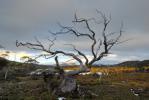I am prompted to write this after listening to a ABC radio interview .
What's the best thing to do if caught in the path of an approaching bushfire , while out on a bushwalk.
Summarizing : If you can, try to get on the lower slope of a hill.. don't get caught above the fire .
Gullies and holes can be traps ....avoid them .
Any more suggestions ?
Mike
Bushfires and bushwalking
Forum rules
The place for bushwalking topics that are not location specific.
The place for bushwalking topics that are not location specific.
12 posts
• Page 1 of 1
Re: Bushfires and bushwalking
Mike, the best would be down slope from the the fire (fire doubles its speed every 10deg increase in slope) surrounded by bare earth or rock. Stay clear of elevated fuel and remember fine fuel burns quick, solid stuff burns slow, get on the black stuff as soon as you can...
All wildfire isn't like you see on telly and I'm crap at writing it's easier to tell you
All wildfire isn't like you see on telly and I'm crap at writing it's easier to tell you
Regards,
Andrew Connell
Andrew Connell
- Wet
- Nothofagus gunnii

- Posts: 13
- Joined: Sun 11 Mar, 2007 7:39 pm
- Location: Doreen Victoria
Re: Bushfires and bushwalking
We were walking on Mt Buffalo on the day the 2003 mega fire started- we watched it get going in the distance actually.
From 6 years in NE Victoria (aka Tinderbox), and 2 major fires, I can completely agree with what has been said- downhill = comparatively safe.
Also, know the extreme fire days. It's easy to check on the Net, and lord knows it's all over the radio. Don't go remote on extreme days, IMHO. I saw the 2003 fire burn all of Mt Buffalo in one afternoon, after 2 weeks of smouldering and being ignored by National Parks (they admitted this), and I've never seen anything like that. Awe-inspiring is not the word for it- terrifying beyond belief is the word for it. On days like that, being downhill is only a temporary measure, as the fire was spotting all over and racing where ever it wanted.
From 6 years in NE Victoria (aka Tinderbox), and 2 major fires, I can completely agree with what has been said- downhill = comparatively safe.
Also, know the extreme fire days. It's easy to check on the Net, and lord knows it's all over the radio. Don't go remote on extreme days, IMHO. I saw the 2003 fire burn all of Mt Buffalo in one afternoon, after 2 weeks of smouldering and being ignored by National Parks (they admitted this), and I've never seen anything like that. Awe-inspiring is not the word for it- terrifying beyond belief is the word for it. On days like that, being downhill is only a temporary measure, as the fire was spotting all over and racing where ever it wanted.
- the_camera_poser
Re: Bushfires and bushwalking
I used to be a CFA volunteer before I moved to Tassie.
Definitely be aware as the other posters have pointed out that fire races uphill. The corollary is that fire burns more slowly downhill.
The main thing to remember is that Radiant Heat is the killer.
Radiant heat is the heat that, well, radiates directly from a fire (as distinct from convection - heat carried on air currents - and conduction).
The important thing with radiant heat is to shield yourself as much as possible. This means covering up exposed skin; even though it's probably going to be hot weather, have a long sleeved shirt and long pants. As the fire front approaches, if you can find an object to shield yourself, such as a fallen log, do so. Other shelters might be a running stream, wet gully, lakes or even the ocean. A good option would be to find a creek with a fallen log in it! Also look out for bare, rocky outcrops. Lie face down, to keep your face covered and to try and find cooler, smoke-free air close to the ground. As a last resort, you may be able to run through low flames onto burnt ground.
Stay in your chosen shelter until the fire has passed and cover any exposed skin with clothing, soft earth, anything at hand to shield you from the radiant heat.
Also keep up your hydration. It's very easy to succumb to heat exhaustion. I was at the 2003 North-East fires, and I know that on one day alone I drank 6 or 9 bottles of Powerade and 3 bottles of plain water. I still got a mild touch of heat exhaustion.
Definitely be aware as the other posters have pointed out that fire races uphill. The corollary is that fire burns more slowly downhill.
The main thing to remember is that Radiant Heat is the killer.
Radiant heat is the heat that, well, radiates directly from a fire (as distinct from convection - heat carried on air currents - and conduction).
The important thing with radiant heat is to shield yourself as much as possible. This means covering up exposed skin; even though it's probably going to be hot weather, have a long sleeved shirt and long pants. As the fire front approaches, if you can find an object to shield yourself, such as a fallen log, do so. Other shelters might be a running stream, wet gully, lakes or even the ocean. A good option would be to find a creek with a fallen log in it! Also look out for bare, rocky outcrops. Lie face down, to keep your face covered and to try and find cooler, smoke-free air close to the ground. As a last resort, you may be able to run through low flames onto burnt ground.
Stay in your chosen shelter until the fire has passed and cover any exposed skin with clothing, soft earth, anything at hand to shield you from the radiant heat.
Also keep up your hydration. It's very easy to succumb to heat exhaustion. I was at the 2003 North-East fires, and I know that on one day alone I drank 6 or 9 bottles of Powerade and 3 bottles of plain water. I still got a mild touch of heat exhaustion.
-

Clownfish - Athrotaxis cupressoides

- Posts: 161
- Joined: Mon 19 Jan, 2009 9:15 am
- Location: Meander Valley, Tasmania
- Region: Tasmania
Re: Bushfires and bushwalking
A rather timely media release from Parks..
http://www.parks.tas.gov.au/index.aspx? ... intID=1338
and a booklet in PDF form (Before you walk...) which also has some notes on epirbs/plb's http://www.parks.tas.gov.au/file.aspx?id=6382
http://www.parks.tas.gov.au/index.aspx? ... intID=1338
and a booklet in PDF form (Before you walk...) which also has some notes on epirbs/plb's http://www.parks.tas.gov.au/file.aspx?id=6382
-

tastrax - Lagarostrobos franklinii

- Posts: 2030
- Joined: Fri 28 Mar, 2008 6:25 pm
- Location: What3words - epic.constable.downplayed
- ASSOCIATED ORGANISATIONS: RETIRED! - Parks and Wildlife Service
- Region: Tasmania
Re: Bushfires and bushwalking
A rather timely media release from Parks..
Dang ... now everyone'll see where I cut and pasted part of my post from!
In my defence - I had already written most of mine, I just looked at that page to fact-check my answer, and thought there were a few bits I had forgotten to mention! True dinks!
-

Clownfish - Athrotaxis cupressoides

- Posts: 161
- Joined: Mon 19 Jan, 2009 9:15 am
- Location: Meander Valley, Tasmania
- Region: Tasmania
Re: Bushfires and bushwalking
-

tastrax - Lagarostrobos franklinii

- Posts: 2030
- Joined: Fri 28 Mar, 2008 6:25 pm
- Location: What3words - epic.constable.downplayed
- ASSOCIATED ORGANISATIONS: RETIRED! - Parks and Wildlife Service
- Region: Tasmania
Re: Bushfires and bushwalking
Clownfish wrote:The important thing with radiant heat is to shield yourself as much as possible. This means covering up exposed skin; even though it's probably going to be hot weather, have a long sleeved shirt and long pants. As the fire front approaches, if you can find an object to shield yourself, such as a fallen log, do so. Other shelters might be a running stream, wet gully, lakes or even the ocean. A good option would be to find a creek with a fallen log in it! Also look out for bare, rocky outcrops. Lie face down, to keep your face covered and to try and find cooler, smoke-free air close to the ground. As a last resort, you may be able to run through low flames onto burnt ground.
A fiew other things worth mentioning:
If possible, avoid wearing nylon or other synthetic clothing (if you're like me, that means most of my bushwalking clobber!). Synthetics burn easily, some can even melt onto your skin - not nice! Cotton is best.
In a severe wildfire, people often get caught by the small spot fires that start up ahead of the fire front. I've been 500m in front of a fire (ex-fire researcher in WA) and had small fires starting up around me, which very quickly start to generate enough smoke to cause confusion. I learnt that one the hard way! It's also something to keep in mind if your lying face down.
With a less severe wildfire, the fire front may only be a few hundred metres wide. In this situation, and particularly if it was moving uphill towards me, I'd opt for moving perpandicular to (ie. across) the face of the fire and, if possible and the flames are low, get back onto burnt land across the flank of the fire.
An emergency blank could be great for shielding against radiant heat (although I do wonder what would happen if it was extreme heat).
Freshly burnt ground can be very hot. Best to have heat resistant soles on shoes/boots.
-

woka - Athrotaxis cupressoides

- Posts: 106
- Joined: Sun 11 May, 2008 7:47 pm
- Location: Kingston, Tasmania
- Region: Tasmania
Re: Bushfires and bushwalking
woka wrote:If possible, avoid wearing nylon or other synthetic clothing (if you're like me, that means most of my bushwalking clobber!). Synthetics burn easily, some can even melt onto your skin - not nice! Cotton is best.
Although keep in mind that cotton has other problems in the more likely situation that you get wet and cold (cotton will get you much colder much faster when wet, or even sweat-damp).
- Son of a Beach
- Lagarostrobos franklinii

- Posts: 6929
- Joined: Thu 01 Mar, 2007 7:55 am
- ASSOCIATED ORGANISATIONS: Bit Map (NIXANZ)
- Region: Tasmania
- Gender: Male
Re: Bushfires and bushwalking
Son of a Beach wrote:Although keep in mind that cotton has other problems in the more likely situation that you get wet and cold (cotton will get you much colder much faster when wet, or even sweat-damp).
All in all, when doing the bushwalking thing, wool would be the best I'd suggest.
TR
"The place between your comfort zone and your dream is where your life takes place." Nick Vujicic.
-

Robbo - Athrotaxis cupressoides

- Posts: 288
- Joined: Sat 07 Jun, 2008 8:31 pm
- Location: Melbourne
- ASSOCIATED ORGANISATIONS: Gilson College
- Region: Victoria
- Gender: Male
Re: Bushfires and bushwalking
Son of a Beach wrote:woka wrote:If possible, avoid wearing nylon or other synthetic clothing (if you're like me, that means most of my bushwalking clobber!). Synthetics burn easily, some can even melt onto your skin - not nice! Cotton is best.
Although keep in mind that cotton has other problems in the more likely situation that you get wet and cold (cotton will get you much colder much faster when wet, or even sweat-damp).
Yep, good point to make! It's not really an issue for a mainland summer, but important for Tassie all year round.
-

woka - Athrotaxis cupressoides

- Posts: 106
- Joined: Sun 11 May, 2008 7:47 pm
- Location: Kingston, Tasmania
- Region: Tasmania
Re: Bushfires and bushwalking
tastrax wrote:A rather timely media release from Parks..
http://www.parks.tas.gov.au/index.aspx? ... intID=1338
and a booklet in PDF form (Before you walk...) which also has some notes on epirbs/plb's http://www.parks.tas.gov.au/file.aspx?id=6382
These are fantastic links.
The second link, the PDF file, is actually (as stated)
Before You Walk - Tasmania's essential bushwalking guide and trip planner.
They may be available as a hard copy from Service Tasmania - you can call to find out on 1300 135513
For those that don't want to download the PDF file (1.6Mb), the bushfire info specific to that file is also on the bottom of
this page - http://www.parks.tas.gov.au/index.aspx?base=6111
-

tasadam - Magnus administratio

- Posts: 5900
- Joined: Tue 10 Apr, 2007 6:58 pm
- Location: Near Devonport, Tasmania
- ASSOCIATED ORGANISATIONS: TasmaniART, Smitten Merino, Macpac
- Region: Tasmania
- Gender: Male
12 posts
• Page 1 of 1
Return to Bushwalking Discussion
Who is online
Users browsing this forum: No registered users and 31 guests
